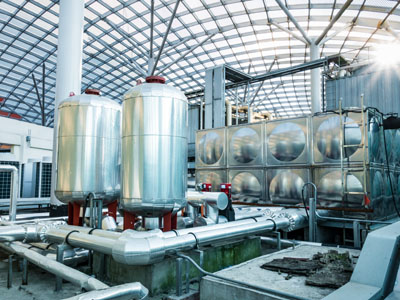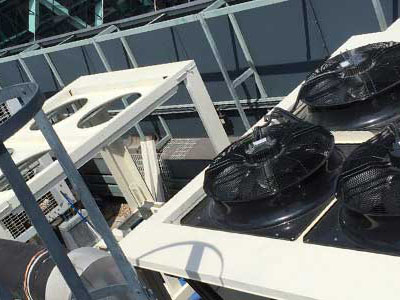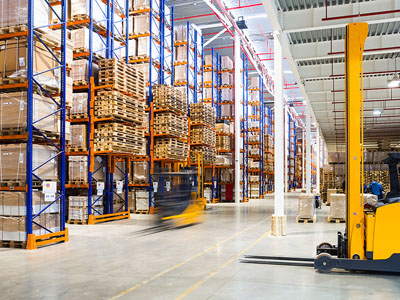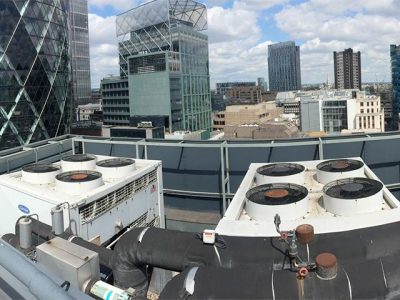
Lofprop Chiller Upgrade
Secondary ReChill® upgrade to Climaveneta Chillers
R513A & Inverter Upgrade Project
Following the continued success of various Inverter technology applications to new and existing chiller projects, ThermOzone developed a new technique to offer a substantial improvement to prior ReChill® projects, where first undertaken prior to the advent of inverter technology.
The site owners, Lofprop, via their Consultants, Humphrey Clarke Consultants Ltd, were very keen to make all efforts to achieve environmental improvements, and are particularly pleased with the achieved results at this prestigious Mayfair site.
This provides a substantial opportunity to further upgrade chillers already subject to our unique ReChill® techniques several years ago and takes into account not only of another substantial reduction in typical operating energy consumption, but also allows onward service of this equipment as the use of HFC refrigerants reduces as part of the EU wide HFC phase down.
50 George Street is a high status suite of offices in the Mayfair district of London. The airconditioning provision for the site is provided by two Climaveneta water chillers situated in a deep basement plant room, using ducted air from street level for the necessary condenser cooling and cooling heat rejection. In 2011 ThermOzone undertook one of our then pioneering projects to retrofit the chillers – conversion from piston to screw compressors; removal or HCFC refrigerant R22; new controls. Since then the chillers have proven hardy and robust and reduced their energy demand then ~35%. However, the mode of ventilation at this site has always been a challenge to meet the increasing cooling demands of the site served.
However, it became obvious we could achieve a significant improvement by applying the more recently developed Inverter Drive techniques. Also use of an inverter allows us to increase the operating frequency and with it compressor speed and displacement. Whereas there was no requirement for increased capacity, this did allow us to consider R513A instead of the HFC R407C which had been selected in 2011 to replace the R22 then in use.
R513A offers several advantages and one significant draw back…
- It is ~8 – 10% more energy efficient at all operating loads than R407C
- It is a lower pressure gas reducing stress on the ageing 1991 original system vessels
Although it is an HFC blend, it has a far lower GWP (Global Warming Potential), and unlike any R22 characteristic gases – R422D; R407C; R438A; etc. Its operating characteristic is near identical to R134a, but with less than half the GWP factor R407C GWP CO2 Tonnes /kg
| R407C | GWP Rating | 1,774 CO2 Tonnes/kg |
| R134a | GWP Rating | 1,430 CO2 Tonnes/kg |
| R513A | GWP Rating | 630 CO2 Tonnes/kg |
R513A offers a lower specific energy transfer effect. This means a higher volume of refrigerant has to be compressed per unit of cooling. Whereas it does this more efficiently, a larger or higher output compressor is required.
The last factor is provided for by use of the Variable Frequency (Speed) Drive Inverter, and the ability to overspeed to regain the required capacity.
However on this specific site the considerably lower operating pressures of using R513A allowed a far better potential resiliency to deal with the difficult ventilation conditions imposed by the nature of the site as far as the cooling air flow is concerned.
The concept was explained to the principal consultants, Humphrey Clarke Consultants, along with energy predictions and a cost analysis showing potential payback.
As an aside the upgrade re-design was predicted and now shown to also provide an effective payback and ongoing increased reliability and efficiency. The project also required to be cost effective from a capital outlay perspective.
Hence the brief we offered was to assign the previously installed screw compressors with inverter drives, a modification and update to the controls then removal of the R407C in favour of R513A. Associated longer term service works are also being undertaken to ensure ongoing longevity of the plant.
Screw Compressors & Load Control by Variable Frequency Drive Inverters
ReChill® has proven modern chiller efficiency can be achieved on most older chiller frames using robust screw compressors and modern controls. However, screw compressors, albeit far more efficient on these applications than piston compressors, themselves have a load efficiency weakness, whereby at partial load the internal load control ‘Slide valve’ reduces energy efficiency progressively below 100% load (displacement volume), with efficiency falling rapidly below 60% slide valve / swept volume at low external load. So effective seasonal load control to satisfy modern demands for an effective SEER / ESEER (efficiencyrating) is a crucial area where innovation is very necessary.
New manufacturers have already shown inverter technology can provide variable speed control as an effective mode of compressor motor control, but this is on fully designed from scratch equipment. The ReChill® challenge was to apply this to an elderly chiller and achieve the same effective gains…
- Smoother start / reduced in rush current & power spikes – starts on ~7 amps
- Effective VFD speed control provides variable load from 60 – 140% compressor standard speed of 50 hz (30 – 70 hz).
- Start / Stop cycles drastically reduced
- Therefore a smaller compressor is selected, providing both cost and load turn down benefits, OR the same capacity can be achieved using a more efficient refrigerant
- Duty for duty the turn down ratio is ~ 40% system load, or 20% chiller load
- Reduced rotor tip blow by at lower speeds further improves volumetric efficiency
- COP / EER > 5.7 at low load operation and > 4 at full load
Proven energy savings of screw compressors replacing piston compressors provides an energy saving closely linked to the lesser pumping efficiency due to cylinder & valve losses of the piston compressor compared with the screw equivalent displacement – e.g. circa 25 – 35%. However, at lower load settings (for most chillers ~ 70% of their annual operating cycle), the screw compressor is not optimised, with the slide valve modulating the load well below its optimum efficiency position (100% loaded).
With VFD Inverter control the slide valve is moved to and held at full load position, optimising the screw compressor at its most efficient. By simply slowing it to match the chilled water cooling demand (the load), the specific efficiency increases, because with lower internal gas flow-rates, internal pumping losses are reduced, with less blow-by of compressed gas across the screw rotor tips. Maintaining the oil lip sealing is simpler as the slower motion is not dragging the oil as much as at higher speeds, although the minimum speed is limited by the requirement for sufficient oil flow to lubricate and seal the screw mechanism and bearings.
Preliminary measurements indicate the inverter control improved part load operating efficiency by as much as a further 35% at low load, and overall it is anticipated the running energy saving will be above 50% all round compared with the original piston compressors. A considerable benefit is the very low start current from the ‘Soft Starter’ feature of the inverter.
Associated works
The upgrade to inverter screws requires dedicated load control technology, achieved from the Magnum Controller, which fully supports Variable Frequency Drive Inverter load speed control. The Magnum also provides ancillary chiller control functions – Electronic expansion valve control; system rotation and comprehensive system fault monitoring.
Follow up
ThermOzone undertake the support PPM at competitive rates. As part of this we have also undertaken pre and post project energy checks using our unique M2M technique ‘RODEM’ whereby we can remotely access the chillers through the Internet to not only monitor but also to adjust for seasonal efficiency optimisation and continuous fine tuning. Our predictions and follow up achievements have used this data to formulate the data presented.
© Trevor Dann – December 2018
Download Full Case Study
To view our full Lofprop case study including the Carbon Trust criteria, please download the case study below.
Posted in the Recent Projects blog category on January 25, 2019.












